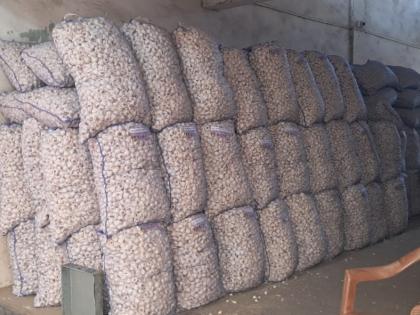Chinese Garlic Enters Mumbai via Afghanistan, Sparking Health Concerns Amid Price Surge
By Amit Srivastava | Updated: September 30, 2024 17:55 IST2024-09-30T17:52:25+5:302024-09-30T17:55:55+5:30
Despite a ban on Chinese garlic imports in India, reports suggest it is entering into the Onion-Potato market of ...

Representational Photo
Despite a ban on Chinese garlic imports in India, reports suggest it is entering into the Onion-Potato market of the Agriculture Produce Market Committee (APMC) in Vashi, Mumbai, through Afghanistan. Although no Chinese garlic has been officially found on the premises, market authorities are on high alert.
Garlic is a key ingredient in kitchens, and large quantities are in demand at hotels and restaurants across the Mumbai Metropolitan Region (MMR).
According to traders, Chinese garlic is being smuggled in via Afghanistan. "The Indian government banned agricultural imports from China, including garlic, several years ago. However, domestic garlic production has declined over the past two months, pushing prices to ₹350 per kilogram in the wholesale market and ₹400 per kilogram in retail," said a trader from the APMC's Onion-Potato section.
With garlic prices soaring, some traders have turned to selling Chinese garlic for higher profits. Initially, these imports came through Nepal, but stricter government enforcement has closed that route. Now, consignments are being sent from China to Afghanistan and labeled as Afghan garlic before entering India.
A trader from APMC warned that Chinese garlic poses health risks due to its high pesticide content. "Chinese garlic was banned in 2014 because it can cause cancer. Indian garlic, on the other hand, contains many beneficial nutrients and compounds," the trader added.
"Consumers should avoid Chinese garlic, even if it’s cheaper, as it could be hazardous to health," the trader advised.
This is the second time garlic prices have reached ₹400 per kilogram this year, the first being in January. A shortage earlier in the year led farmers to sell off large quantities, impacting warehouse stocks and leading to the current supply crunch.
Garlic is primarily cultivated in Madhya Pradesh, Rajasthan, Gujarat, and Uttar Pradesh, with some production in Karnataka and Maharashtra. China remains the world's largest producer of garlic.
Open in app